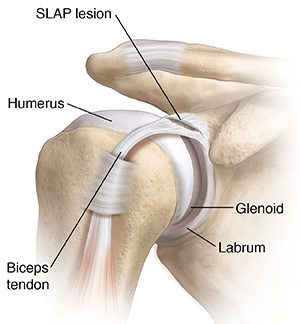SLAP Lesion of the Shoulder Joint
The shoulder is the most mobile joint in your body. The ball or “head” of the arm bone (humerus) rests in a shallow rounded socket called the glenoid. To help make the socket deeper, the outer rim of the glenoid is ringed by tough, flexible tissue called the labrum.
What Is a SLAP Lesion?
SLAP stands for superior labrum anterior to posterior. This means that the upper rim of the labrum has been torn from front to back. The tear happens where the biceps tendon attaches to the labrum. Common causes of a SLAP lesion include:
-
Falling on an outstretched hand
-
Forceful lifting or pulling on the arm, such as trying to catch a heavy object
-
Repeated overhead motions (such as throwing)
-
Shoulder dislocation

Diagnosing a SLAP lesion
To diagnose the problem, your healthcare provider will check your arm and shoulder. This includes moving your arm in certain directions to test for symptoms. You may also have imaging tests such as an X-ray, MRI, or CT scan. They may be done to evaluate the lesion and to look for other injuries such as breaks (fractures) or rotator cuff tears. These provide your provider with a detailed view of the tissues inside your shoulder joint.
Treating a SLAP lesion
Rest and anti-inflammatory medicines are often the first line of treatment. Injections of steroid medicine may be used. Physical therapy can also be used to strengthen the muscles in the shoulder. This helps keep the joint stable. If these treatments aren’t enough, your provider may advise surgery to repair the labrum.
© 2000-2025 The StayWell Company, LLC. All rights reserved. This information is not intended as a substitute for professional medical care. Always follow your healthcare professional's instructions.